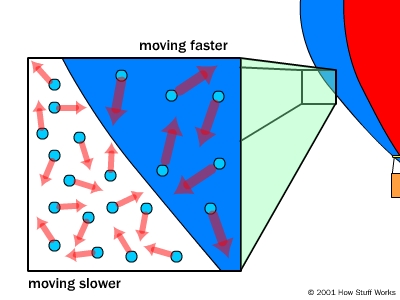|
In the last section, we saw that the atmosphere's buoyant force will only lift with a force equal to the weight of air the object displaces. So, for buoyancy to push something up in the air, the thing has to be lighter than an equal volume of the air around it.
The most obvious thing that is lighter than air is nothing at all. A vacuum can have volume but does not have mass, and so, it would seem, a balloon with a vacuum inside should be lifted by the buoyancy of the air around it. This doesn't work, however, because of the force of surrounding air pressure. Air pressure doesn't crush an inflated balloon, because the air inside the balloon pushes out with the same force as the outside air pushing in. A vacuum, on the other hand, doesn't have any outward pressure, since it has no particles bouncing against anything. Without equal pressure balancing it out, the outside air pressure will easily crush the balloon. And any container strong enough to hold up to the air pressure at the earth's surface will be much too heavy to be lifted by the buoyant force.
Another option would be to fill the balloon with air that is less dense than the surrounding air. Because the air in the balloon has less mass per unit of volume than the air in the atmosphere, it would be lighter than the air it was displacing, so the buoyant force would lift the balloon up. But again, fewer air particles per volume means lower air pressure, so the surrounding air pressure would squeeze the balloon until the air density inside was equal to the air density outside.
All of this is assuming that the air in the balloon and the air outside the balloon exist under exactly the same conditions. If we change the conditions of the air inside the balloon, we can decrease density, while keeping air pressure the same. As we saw in the last section, the force of air pressure on an object depends on how often air particles collide with that object, as well as the force of each collision. We saw that we can increase overall pressure in two ways:
-
Increase the number of air particles so there is a greater number of particle impacts over a given surface area.
-
Increase the speed of the particles so that the particles hit an area more often and each particle collides with greater force.

There are fewer air particles per unit of volume inside the balloon, but because those particles are moving faster, the inside and outside air pressure are the same. |
So, to lower air density in a balloon without losing air pressure, you simply need to increase the speed of the air particles. You can do this very easily by heating the air. The air particles absorb the heat energy and become more excited. This makes them move faster, which means they collide with a surface more often, and with greater force.
For this reason, hot air exerts greater air pressure per particle than cold air, so you don't need as many air particles to build to the same pressure level. So a hot air balloon rises because it is filled with hot, less dense air and is surrounded by colder, more dense air.
|



